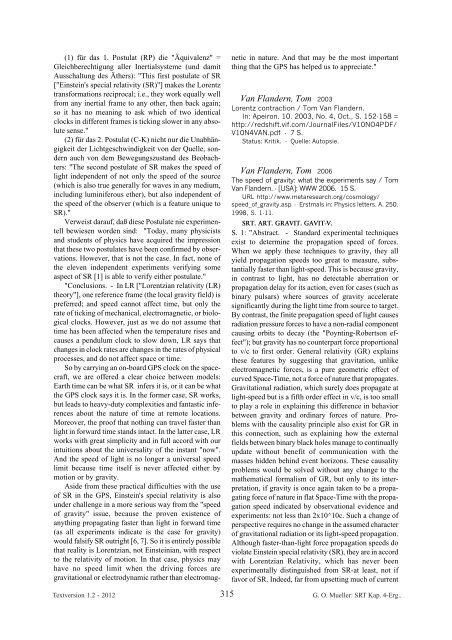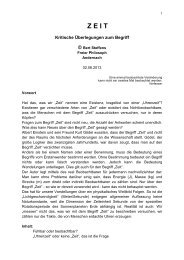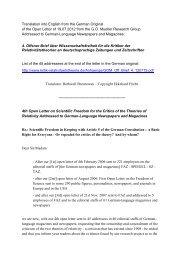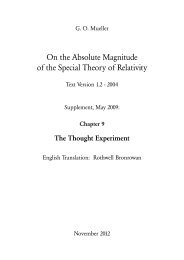2394 weitere kritische Veröffentlichungen - Kritische Stimmen zur ...
2394 weitere kritische Veröffentlichungen - Kritische Stimmen zur ...
2394 weitere kritische Veröffentlichungen - Kritische Stimmen zur ...
Sie wollen auch ein ePaper? Erhöhen Sie die Reichweite Ihrer Titel.
YUMPU macht aus Druck-PDFs automatisch weboptimierte ePaper, die Google liebt.
(1) für das 1. Postulat (RP) die "Äquivalenz" =<br />
Gleichberechtigung aller Inertialsysteme (und damit<br />
Ausschaltung des Äthers): "This first postulate of SR<br />
["Einstein's special relativity (SR)"] makes the Lorentz<br />
transformations reciprocal; i.e., they work equally well<br />
from any inertial frame to any other, then back again;<br />
so it has no meaning to ask which of two identical<br />
clocks in different frames is ticking slower in any absolute<br />
sense."<br />
(2) für das 2. Postulat (C-K) nicht nur die Unabhängigkeit<br />
der Lichtgeschwindigkeit von der Quelle, sondern<br />
auch von dem Bewegungszustand des Beobachters:<br />
"The second postulate of SR makes the speed of<br />
light independent of not only the speed of the source<br />
(which is also true generally for waves in any medium,<br />
including luminiferous ether), but also independent of<br />
the speed of the observer (which is a feature unique to<br />
SR)."<br />
Verweist darauf, daß diese Postulate nie experimentell<br />
bewiesen worden sind: "Today, many physicists<br />
and students of physics have acquired the impression<br />
that these two postulates have been confirmed by observations.<br />
However, that is not the case. In fact, none of<br />
the eleven independent experiments verifying some<br />
aspect of SR [1] is able to verify either postulate."<br />
"Conclusions. - In LR ["Lorentzian relativity (LR)<br />
theory"], one reference frame (the local gravity field) is<br />
preferred; and speed cannot affect time, but only the<br />
rate of ticking of mechanical, electromagnetic, or biological<br />
clocks. However, just as we do not assume that<br />
time has been affected when the temperature rises and<br />
causes a pendulum clock to slow down, LR says that<br />
changes in clock rates are changes in the rates of physical<br />
processes, and do not affect space or time.<br />
So by carrying an on-board GPS clock on the spacecraft,<br />
we are offered a clear choice between models:<br />
Earth time can be what SR infers it is, or it can be what<br />
the GPS clock says it is. In the former case, SR works,<br />
but leads to heavy-duty complexities and fantastic inferences<br />
about the nature of time at remote locations.<br />
Moreover, the proof that nothing can travel faster than<br />
light in forward time stands intact. In the latter case, LR<br />
works with great simplicity and in full accord with our<br />
intuitions about the universality of the instant "now".<br />
And the speed of light is no longer a universal speed<br />
limit because time itself is never affected either by<br />
motion or by gravity.<br />
Aside from these practical difficulties with the use<br />
of SR in the GPS, Einstein's special relativity is also<br />
under challenge in a more serious way from the "speed<br />
of gravity" issue, because the proven existence of<br />
anything propagating faster than light in forward time<br />
(as all experiments indicate is the case for gravity)<br />
would falsify SR outright [6, 7]. So it is entirely possible<br />
that reality is Lorentzian, not Einsteinian, with respect<br />
to the relativity of motion. In that case, physics may<br />
have no speed limit when the driving forces are<br />
gravitational or electrodynamic rather than electromag-<br />
netic in nature. And that may be the most important<br />
thing that the GPS has helped us to appreciate."<br />
Van Flandern, Tom 2003<br />
Lorentz contraction / Tom Van Flandern.<br />
In: Apeiron. 10. 2003, No. 4, Oct., S. 152-158 =<br />
http://redshift.vif.com/JournalFiles/V10NO4PDF/<br />
V10N4VAN.pdf - 7 S.<br />
Status: Kritik. - Quelle: Autopsie.<br />
Van Flandern, Tom 2006<br />
The speed of gravity: what the experiments say / Tom<br />
Van Flandern. - [USA]: WWW 2006. 15 S.<br />
URL http://www.metaresearch.org/cosmology/<br />
speed_of_gravity.asp - Erstmals in: Physics letters. A. 250.<br />
1998, S. 1-11.<br />
SRT. ART. GRAVIT. GAVIT-V.<br />
S. 1: "Abstract. - Standard experimental techniques<br />
exist to determine the propagation speed of forces.<br />
When we apply these techniques to gravity, they all<br />
yield propagation speeds too great to measure, substantially<br />
faster than light-speed. This is because gravity,<br />
in contrast to light, has no detectable aberration or<br />
propagation delay for its action, even for cases (such as<br />
binary pulsars) where sources of gravity accelerate<br />
significantly during the light time from source to target.<br />
By contrast, the finite propagation speed of light causes<br />
radiation pressure forces to have a non-radial component<br />
causing orbits to decay (the "Poynting-Robertson effect");<br />
but gravity has no counterpart force proportional<br />
to v/c to first order. General relativity (GR) explains<br />
these features by suggesting that gravitation, unlike<br />
electromagnetic forces, is a pure geometric effect of<br />
curved Space-Time, not a force of nature that propagates.<br />
Gravitational radiation, which surely does propagate at<br />
light-speed but is a fifth order effect in v/c, is too small<br />
to play a role in explaining this difference in behavior<br />
between gravity and ordinary forces of nature. Problems<br />
with the causality principle also exist for GR in<br />
this connection, such as explaining how the external<br />
fields between binary black holes manage to continually<br />
update without benefit of communication with the<br />
masses hidden behind event horizons. These causality<br />
problems would be solved without any change to the<br />
mathematical formalism of GR, but only to its interpretation,<br />
if gravity is once again taken to be a propagating<br />
force of nature in flat Space-Time with the propagation<br />
speed indicated by observational evidence and<br />
experiments: not less than 2x10^10c. Such a change of<br />
perspective requires no change in the assumed character<br />
of gravitational radiation or its light-speed propagation.<br />
Although faster-than-light force propagation speeds do<br />
violate Einstein special relativity (SR), they are in accord<br />
with Lorentzian Relativity, which has never been<br />
experimentally distinguished from SR-at least, not if<br />
favor of SR. Indeed, far from upsetting much of current<br />
Textversion 1.2 - 2012 315<br />
G. O. Mueller: SRT Kap. 4-Erg..





